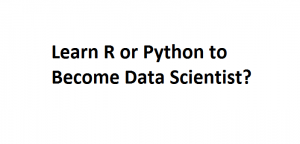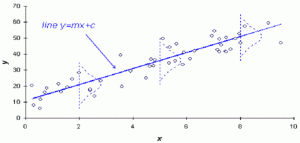Top 10 Simpler Interview Questions, Architects Find Difficult to Answer

This article represents my list of top 10 interview questions which I see people, appearing for technical architect position, find difficult to answer. Although these questions seem to be simpler and subjective, I found candidates finding it difficult to answer. Do check the list below and see if you cracked all of them. Please feel free to comment/suggest if you would want me to include other questions. Sorry for the typos. Top 10 Interview Questions, Technical Architects Find Difficult to Answer Architecture & Design: Questions below are intended to test the candidates understanding on architectural frameworks and their abilities/capabilities to lay down system architecture/design. What are 3-4 most common …
Learn R or Python for Becoming Data Scientist?

This article presents analysis on whether one should go for learning R or Python programming language to create one or more predictive models using different machine learning algorithms. It could be noted that both languages, R and Python, is equally doing good and sought after by developers and the companies hiring such developers. So, you could choose either one of these languages. However, majority has been found to be voted in favour of Python for ease of learning and greater community support. Data Scientist with expertise in R Following indeed.com plot represents the job trends for the search term, “Data Scientist R”. It clearly indicates the trend such as …
Hello React Native! You Are So Cool!

This article represents a very high level introduction to React-Native platform and, highlights some of the key reasons as to why one would want to try and adopt this yet another mobile apps framework used for building native apps. Please feel free to comment/suggest if I missed to mention one or more important points. Also, sorry for the typos. React-Native is a framework for building native apps using ReactJS javascript framework. As of current release, it supports building iOS native apps using ReactJS framework. However, the primary objective has been to take the best of web and native platform and create a UIDeveloper-friendly framework that allows developers to write mobile …
Top 5 Interview Questions for Mobile Hybrid Apps Developer

This article represents top 5 most commonly asked interview questions for mobile hybrid apps developers. Please feel free to comment/suggest if you think of another most commonly asked interview questions in relation with hybrid apps development. Also, sorry for the typos. Top 5 Interview Questions for Mobile App Developers What are hybrid mobile apps? Ans: A detailed answer could be found here How are hybrid apps different from building native apps and mobile websites? Ans: Detailed answer could be found on this page. Why build native apps, when hybrid apps development frameworks are there? Ans: Some of the following could not be achieved effectively using web frameworks: Access to …
Machine Learning – Top 16 Learning Resources on Statistics

This article represents some of the top learning resources (webpages, videos etc) on my frequent visit list. Please feel free to comment/suggest if I missed to mention one or more important points. Also, sorry for the typos. Following are the key categories of webpages/videos that are expanded later in this article: Websites Quora Youtube Videos Coursera courses Khan Academy Top 16 Learning Resources on Statistics Folllowing is the list of URLs for these learning resources: Websites on Statistics Stattrek.com Elementary Statistics with R StatsDirect.com Usable Stats Quora.com Statistics Channel Probability & Statistics Statistics (Acacedmic Discipline) Bayesian Inference Youtube Videos Playlists on Statistics Brandon Foltz StatisticsFun JBStatistics Quantitative Specialists Coursera Courses …
Machine Learning Research in Top 10 US Universities

This article represents information related with machine learning departments & related research projects in top 10 US universities (as per USNews Ranking). I have put it together for my quick reference and thought to share with you for the same purpose. Please feel free to comment/suggest if I missed to mention one or more important points. Also, sorry for the typos. Following are top 10 universities covered later in this article: Princeton University Harvard University Yale University Columbia University Stanford University University of Chicago MIT Duke University University of Pennsylvania California Institue of Technology Machine Learning @ Top 10 US Universities Princeton University: Machine Learning Department at Princeton University …
Data Science – 175 Probability & Statistics Interview Questions

This article presents URL and short description of around 175 probability & statistics objective questions which could prove very useful and helpful for those who are planning to attend one or more data scientist interviews in time to come. These tests/quizzes were created when I was learning probability and statistics some time back and, found various concepts interesting enough to be converted into quizzes for my future references. As probability & statistics form key to data science, it may be worth spending some time on these tests and check your understanding. You may also use this for your future reference. These questions could also be used for checking your concepts …
Quick Cheat Sheet for Big Data Technologies
This article represents quick details on some of the key open-source technologies (tools & frameworks) associated with Big Data. The objective of this article is to present quick details on open-source tools & frameworks in a well-categorized manner using top-down approach where data engineering and data science aspects of Big Data is associated with relevant tools & framework. Most of these tools and frameworks could be found with commercial Hadoop distributions such as Cloudera, Hortonworks, MapR etc. Please feel free to comment/suggest if I missed to mention one or more important frameworks. Also, sorry for the typos. Following is the key classication of tools/frameworks that have been briefed later in …
Machine Learning – Top 5 Video Channels for Regression Models

This article represents top 5 video channels that one could use to learn and become expert at regression models. I make visits to watch these videos, once in a while, to clarify my doubts in relation with regression models. As I find these pages very useful, I thought it to share with you all. These are some real good videos from learning perspective that could help you get started with regression models and get a good hang of it within no time. Please feel free to share it with your community. Please feel free to comment/suggest if I missed to mention any other great video channels. Also, sorry for the …
Data Science – Top 10 Websites to Bookmark for Daily News

This article represents links and information in relation with top 10 websites that publishes data science related news and article on daily/regular basis. These links are my favorites and help me remain up-to-date with latest and greatest happening in the field of data science. Please feel free to comment/suggest if I missed to mention/include one or more important and interesting websites in the list given below. Also, sorry for the typos. Following are the key points described later in this article: Top 5 Data Science News Websites – Recommended Daily Visit Top 5 Data Science News Websites – Recommended Regular Visit Top 5 Data Science News Websites – Recommended …
Machine Learning – Mathematical Concepts for Linear Regression Models

This article represents some of the key mathematics & statistics concepts that one may need to learn in order to work with linear regression models. Understanding following concepts would help in some of the following manners in relation with evaluating linear regression models: Interpreting coefficients Evaluating the regression model Comparing multiple regression models and choosing the best out of them Please feel free to comment/suggest if I missed to mention one or more important points. Also, sorry for the typos. Following are the key mathematical concepts/topics described later in this article: Statistical hypothesis testing Probability distributions Quantitative data analysis Plots Key Mathematics & Statistics Topics for Linear Regression Models …
Data Science – Descriptive Vs Predictive Vs Prescriptive Analytics

This article represents key classification or types of analytics that business stakeholders, in this Big Data age, would want to adopt in order to take the most informed and smarter decisions for better business outcomes. Please feel free to comment/suggest if I missed to mention one or more important points. Also, sorry for the typos. Following are the key categories of analytics which are described later in this article: Descriptive Analytics Predictive Analytics Prescriptive Analytics What is Descriptive Analytics? Descriptive analytics answers the question or gains insights into or summarize, “What has happened?”. This could be seen as first stage of business analytics and still accounts for the majority of …
Data Science – Key Algebra Topics to Master

This article represents some of the key topics in Algebra that one may need to brush up or master in order to get good at understanding different aspects of machine learning algorithms. If you are gearing up to become the data scientist, the topics below may be worth your attention as I had to brush them up eventually when I was learning different machine learning algorithms. The concepts listed below, especially related with linear algebra, touches almost all machine learning algorithms. Please feel free to comment/suggest if I missed to mention one or more important points. Also, sorry for the typos. Following are the key high level topics which are …
Data Science – Key Probability & Statistics Topics to Master

This article represents a list of key probability & statistics topics that one may need to master if he is aiming to become a data scientist. This article lists topics that has worked for me so far in relation with working on a data science problem. One could also see the below list as table of content for key probability and statistics topics for data science. However, I do believe that there are some topics that I might not have mentioned. Please feel free to comment/suggest if I missed to mention one or more important points. Also, sorry for the typos. Probability & Statistics Topics Following are some of the …
Learn R – How to Get Random Training and Test Data Set
This article represents sample source code which could be used to extract random training and test data set from a data frame using R programming language. The R code below could prove very handy while you are working to create a model using any machine learning algorithm. Please feel free to comment/suggest if I missed to mention one or more important points. Also, sorry for the typos. # Read the data from a file; The command below assumes that the working # directory has already been set. One could set working directory using # setwd() command. sample_df <- read.csv(“glass.data”, header=TRUE, stringsAsFactors=FALSE) # get a vector comprising of all indices …
Machine Learning – Bookmarks for Great Tutorials, Books & Videos
This article represents quick bookmarks on some good machine learning web pages including tutorials’ documents and videos. Please feel free to comment/suggest if you know of further good bookmarks. I shall be adding more bookmarks in time to come. Also, sorry for the typos. Following are the key bookmarks: List of Tutorial Pages on Different Machine Learning Topics: You shall surely want to bookmark this page as it consists of some real cool links covering different topics in machine learning. List of Machine Learning Books: Those looking out for machine learning books to get started would want to bookmark this page which consists of list of some great books recommended …
I found it very helpful. However the differences are not too understandable for me